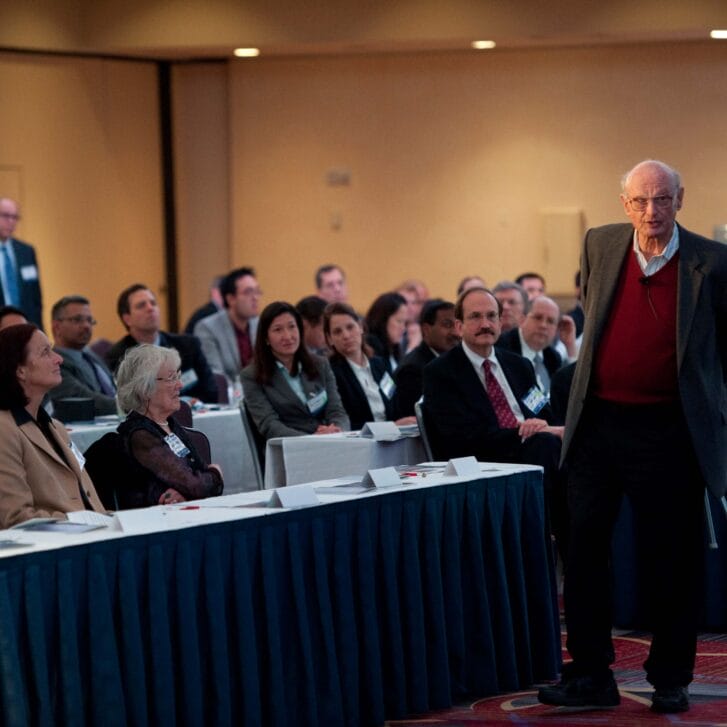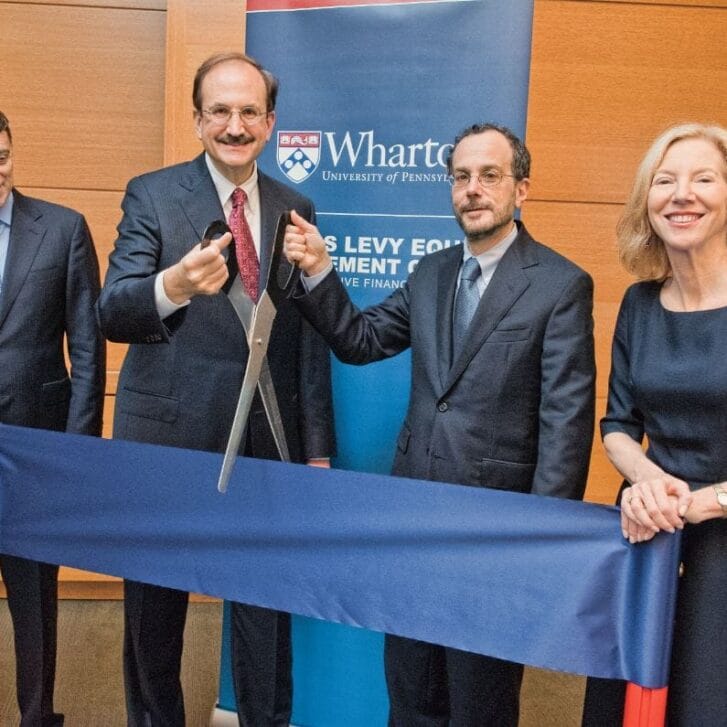Lee S. Hillman, W’77: Flexing His Muscles in the Fitness Business
Imagine having a health and fitness company with nearly 4 million members, whose clubs are located within a 10-mile drive of 60 percent of Americans, that is signing up about 700,000 new members each year, and whose advertising reaches about 200 million potential customers a month.
“We touch an awful lot of people,” says Lee Hillman, president and CEO of Chicago-based Bally Total Fitness Holding Corp.
It wasn’t always that way. When Hillman first took the reins of Bally in October 1996, the company had a reputation for sliding revenues, an unhealthy membership default rate and an anemic stock price that was hovering around 5 (it’s currently in the mid-20s, down from a pre-slump high of 37 last summer).
Today, the company is robust. Bally Total Fitness, with 12,500 employees, had revenues of $639 million in 1996, $661 million in 1997 and $743 million in 1998. Operating margins have doubled from 7 percent in early 1997 to 14 percent in 1998. And in a recent independent research study, 87 percent of all Americans identified Bally as the first name they thought of in fitness.
It’s a trajectory that Hillman is bent on maintaining through a number of aggressive strategies, new products and creative alliances.
For example, rather than emphasizing low-margin, single-club paid-in-full memberships, as the company had previously done, Hillman has focused on higher-margin, higher-value, multi-club memberships that people typically choose to finance over a three-year period. The approach, he says, has paid off in significantly higher membership revenues and more satisfied customers.
In addition, Hillman is promoting senior fitness programs, especially in densely populated retirement areas like Arizona and Florida, and expanding the physical rehabilitation side of the business by opening centers with Orange, N.J.-based Kessler Rehabilitation Institute. Six centers are open now, four more are in the works, and a total of 100 are planned over the next three years in the Eastern corridor. Hillman has similar plans with hospital groups and major chiropractors in the Midwest and West and already has 10 of these up and running..
About 250 of the company’s 330 fitness centers have undergone major or minor refurbishments in the past 16 months, and more than 100 retail shops within the clubs now offer nutritional supplements, exercise clothing and equipment and other fitness-related items.
Recognizing an opportunity to customize and upgrade the fitness experience, Hillman has expanded the number of personal trainers in the Bally system from 50 to 1,400, making that area the company’s largest revenue generator aside from general membership fees and dues. He has added new brands to the flagship Bally Total Fitness brand, including Bally Sports Clubs on the East coast and Pinnacle Fitness by Bally on the West coast, both for upscale professional urban and suburban types. His fourth brand, Gorilla Sports, refers to “very edgy, fitness-oriented training centers that are urban and hip and offer such classes as kick boxing, tai chi, kwando, aerobics and Bikram yoga,” says Hillman, noting that women hold slightly more than two-thirds of Gorilla Sports memberships. Gorilla Sports is a mainstay in fitness articles appearing in lifestyle magazines targeting women, he adds.
Many Bally clubs around the country feature lectures on medical topics, self-defense, fitness and nutrition, an initiative that will expand over the next few years. In 1998, the company established its Bally Total Fitness Sports Medical Advisory Board, with leading experts in “sports medicine, nutrition, women’s health, geriatric health, wellness and everything in between,” says Hillman. “Our advisory board is helping us with development of our lecture series, related articles and cooperative relationships with other health care institutes that don’t have the ability, as we do through our distribution channels, to reach out to the general public and talk about the benefits of exercise, fitness and good nutrition.”
Hillman is taking steps to make sure the benefits of fitness also reach audiences such as inner city schools, park districts and police athletic leagues, to which Bally donates used exercise equipment through its “Stronger Communities” campaign. The amount of equipment donated was valued at more than $4 million last year alone.
A self-described “numbers guy” who earned an MBA from the University of Chicago, Hillman was a partner in the Chicago office of Ernst & Young when he was hired in 1991 by Arthur Goldberg to assist in the financial restructuring of Bally Entertainment Corp., a role which ended upon completion of the company’s merger with Hilton Hotels Corp. in 1997. Hillman was named president and CEO of Bally Total Fitness in October 1996 after serving as Bally Entertainment’s CFO. The company had been a subsidiary of Bally Entertainment until it was spun off in January 1996.
Hillman, who lives in a Chicago suburb with his wife and two children, admits he works out five or six days a week but declines the label of “fanatic.” “I’m a regular guy when it comes to workouts. After I left Wharton I got away from playing sports until four years ago when one of the guys at Bally Entertainment encouraged me to begin working out at the clubs. I started realizing not only how much better I felt but how much my health improved and how much more productive I was in the office. There is no substitute for this. You can’t take a pill, can’t diet your way into it, can’t go through a medical procedure for it. You just have to go and exercise.”
Lucinda B. Duncalfe, WG’91: In Touch with Technology
 Lucinda B. Duncalfe, CEO of Destiny Software Corp. in Conshohocken, Pa., didn’t start out with her mind set on a career in business.
Lucinda B. Duncalfe, CEO of Destiny Software Corp. in Conshohocken, Pa., didn’t start out with her mind set on a career in business.
“I guess my background was a little squishy,” says Duncalfe, whose company provides online products and services to financial institutions. “It was a bit of a circular path for me to get here.”
When Duncalfe, C’85 and WG’91, arrived at Penn her freshman year her only goal was to play basketball (she made varsity). “I signed up for an introductory psychology course with about 800 students and got an A,” she said. “If I could get an A with all the traveling and practice that basketball took, I knew this was the major for me. I took so many psych courses that I [completed] the major in two years.”
After graduation, she canvassed for environmental groups, worked in a bookstore and eventually landed an entry-level job at Dial-Info, a voice-response technology firm in Silicon Valley.
“All of a sudden, I found it — business, and I loved it,” says Duncalfe. “All the fundamental skills of a liberal arts education came together for me.”
She spent time in every facet of the company, from marketing to sales to product development. Deciding she needed some basic financial skills, she went back to Wharton for her MBA and then joined SEI Corp., a Philadelphia-based technology and investment company. After five years she left to become product management director at Infonautics, an online start-up. It was 1996.
A few months later a former col-league from SEI asked her to talk with the two founders of a firm called Destiny Software who were looking for marketing assistance. Duncalfe agreed to meet them that Saturday. “They gave me a 100-page business plan, which was about three times too long,” says Duncalfe. “I told them they might need a marketing person, but first off they needed a CEO to get things together.”
Two days later, Lester Shuda Jr., the company’s founder, called to tell her that she was right, Destiny needed a CEO. Would she take the job? “I thought about how ready I was for it, and I went for it,” Duncalfe says.
Since she joined Destiny in December 1996, Duncalfe has added 30 more workers and considerably expanded the company’s services and client roster. Destiny’s Granite Foundation and Granite Sculptor software allows credit card issuers, private banks and other financial institutions to deliver their products over the Internet, the Open Financial Exchange, American Online and other electronic channels. Among Destiny’s clients are Bank of America, the Northern Trust Company, Advanta, GE Capital and First USA of Wilmington.
Though she doesn’t play much basketball any more, Duncalfe relies a lot on lessons learned during her varsity years.
Playing basketball, she says, “is hard work and somewhat disorganized work. You have to be able to take coaching and then go off by yourself to figure out how to become better. Then there is the aspect of teamwork. You basically live with other team members, which means they sometimes grate on you. You have to learn to overcome that and work with them. It is not much different than what we do in a company like this, where we work long hours together on a big project.”
Unlike the 24-hour-a-day Silicon Valley work ethic, Duncalfe advocates employees having a “real life.” She is a dedicated hiker, backpacker, kayaker and rower. Last winter, she took a water-sports vacation in French Polynesia.
Duncalfe sees being in the Delaware, not Silicon, Valley as a plus. “You can hire good people who don’t have to spend everything they earn on a place to live. If there is a downside, it’s that we’re not right at the center of the technology venture capital community, but hopefully Destiny is past that point now. I still go to California every few weeks to keep in touch with [new developments] but we can work on cutting-edge technology here just as well as there.”
Roland Wolfram, WG’86: New Initiatives at Nike
 When Michael Jordan announced his retirement in January, many people probably wondered what would happen to basketball now that its most revered star was taking himself out of the game.
When Michael Jordan announced his retirement in January, many people probably wondered what would happen to basketball now that its most revered star was taking himself out of the game.
In Beaverton, Ore., many are probably wondering what will happen to Nike, Inc. as well, now that the $9.3 billion company’s premier spokesman will no longer be a pro ball player. “Certainly it will mean a change for us,” says Roland Wolfram, Nike’s new vice president of strategic planning. “But it’s important to remember that Nike has a long-term arrangement with Jordan that goes well into the 21st century. It’s based on a relationship that has been built up over many years. A full team of people here will continue to work on brand Jordan although the strategy will obviously be different than it has been in the past.”
More is changing at Nike than the basketball status of Michael Jordan. Wolfram was brought into the company last December specifically to help identify long-term strategic opportunities and evaluate new business development ideas. He reports jointly to Nike CEO Philip Knight and president Thomas Clarke.
“One of the nice things about working for a company that is so well known and respected is that you don’t have to spend a lot of time describing what the company does,” says Wolfram, a University of Maryland graduate who spent the last five years as vice president and general manager of Pacific Bell Video Services in San Ramon, Cal.
“Nike is number one in a lot of categories and in some cases has huge market share. But it’s also been a tough business environment for the past year. The whole athletic footwear and apparel industry has been on the ropes. So in some ways there are more challenges for the number one company rather than less. It means we need to focus hard on being competitive, managing our economies and creating new products.”
Such as two new business units, one for golf and another called All Conditions Gear, an outdoor division aimed at outfitting hikers, trail runners, mountain bikers and snow boarders. Nike also has plans to ratchet up one of its subsidiaries, Bauer, Inc., the world’s leading manufacturer of hockey equipment. “We have consolidated our Nike hockey business with Bauer and are trying to apply some of our best technology to that area. Bauer has a great heritage. We can see synergies there with our core business.”
In addition, Nike owns Cole Haan, which markets a line of high-quality men’s and women’s dress and casual shoes, and Sports Specialties Corp., which markets a full line of licensed headwear.
“Nike is so broad now that while its core has traditionally been running and basketball shoes it also has a substantial presence in tennis, soccer, hiking, cross training and a lot of other categories,” says Wolfram, a self-described weekend soccer player, skier and hiker who moved to Beaverton this winter with his wife and three daughters. Which is not to say that it hasn’t been a tough year for sports companies. First, there are the charges that Nike’s swoosh is so overexposed that the company can no longer control its distribution or the image it projects. “Nike’s view is that its identity is the swoosh,” says Wolfram. “It’s a proud heritage and the company is continuing to put its energy behind it.” Second have been news stories about alleged mistreatment of workers in Nike’s Asian manufacturing operations, an issue that Wolfram says the company is addressing head-on by monitoring and upgrading labor conditions in factories abroad, among other actions.
Third is the fans’ increasing disenchantment with pro sports, from the NBA strike this year to the baseball strike in 1994-95. “But then you had a season where the Yankees win, and you have players like Mark McGwire, Sammy Sosa and Cal Ripken, and you can see baseball’s shining points once again,” Wolfram says. “I think pro basketball will come around as well.”
Does pro sports’ bad image affect Nike’s sales? Wolfram thinks not. “A lot of what Nike is about involves people trying to do the best they can. The advertising says it: just do it, there is no finish line. It doesn’t matter if you run an eight-minute mile or a four-minute mile. Just go out and do your best.”

























